
Two of the most common culprits of storm damage are wind and hail. Whether a tornado, severe thunderstorm, tropical storm or something else rolled through the area, high winds and hail stones are almost always present. But what type of damage can either of these two elements do on their own, and which is worse for the roof over your home?
RROC, LLC is a seasoned roofer and remodeler in the Olympia area, with over 25 years of combined experience to our name. We install and replace several different types of roofing, and have seen extensive damage from both strong winds and hailstorms. Below we outline some similarities and differences between the two, giving homeowners some insight into what to expect after the next storm.
Shingles are Lifting at the Edges
After experiencing a storm, many homeowners notice lifted shingles. This type of damage is typically done by high winds, which can create a suction effect. This results in the edges of a shingle lifting upwards. Even if the shingle is technically still attached to your roof deck, the adhesive has significantly weakened if the corners have peeled off, and the chances of water leaking through are much higher.
There are many more indicators that high winds have lessened the quality of your shingles, including:
- Missing Shingles
- Loosened Shingles
- Curled Shingles
- Buckled Shingles
- Torn Shingles
Damage to Gutters and Downspouts
Both high winds and hailstorms can leave your gutters in bad shape. After severe weather, it isn't uncommon for gutters to come unattached from the roofline, either due to the impact of hail stones or the pressure of strong winds. After hail, gutter damage could include:
- Dented Gutters
- Holes in Gutters
- Damaged Leaf Guards
- Loosened or Broken Brackets
When winds reach a certain speed, they can also cause gutters to detach from the roofline, or even warp them if the brackets stay intact. High winds also have the capability of hurtling debris at your gutters, which could result in broken gutters and downspouts.
Deteriorated and Bald Shingles
An aspect of storm damage that can sometimes be hard to miss is when the reflective asphalt granules get stripped off of the shingle itself, typically washing into the gutters. This deterioration can easily be caused by the impact of hail stones, but when winds are strong enough, they have also been known to leave roofing products bald, and therefore unprotected against harmful UV rays and other elements.
Leaks and Water Damage
Hail and high winds are equally capable of leaving your roof compromised to the point that water is able to seep through. Whether because of a puncture from hail or exposed materials from high winds, both elements have been known to result in leaky roofs. When leaks start off small, they can be hard to catch at first. Some of the common signs to look for include:
- Yellow or Brown Stains on Ceiling
- Musty Smell in the Attic
- Excess Moisture in the Air
- Presence of Mold and Mildew
- Sound of Dripping Water
One way to avoid experiencing more damage than necessary when bad weather strikes is by working with expert roofers for your roof installation, like RROC Exteriors. We ensure precision on each roof we replace, and only work with industry-leading roofing materials from brands like GAF so that our new roof replacements are equally durable, reliable and beautiful. Get in touch with our team today for more information, and get a free estimate on a complete roof replacement from our top-rated roofers.
Subscribe to RROC Exteriors's Blog







